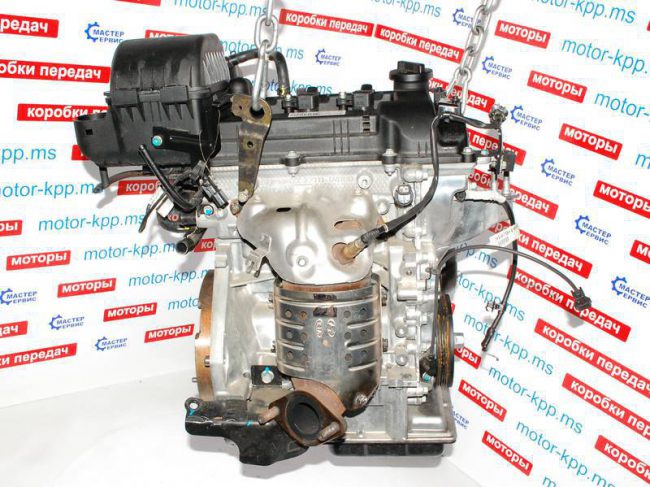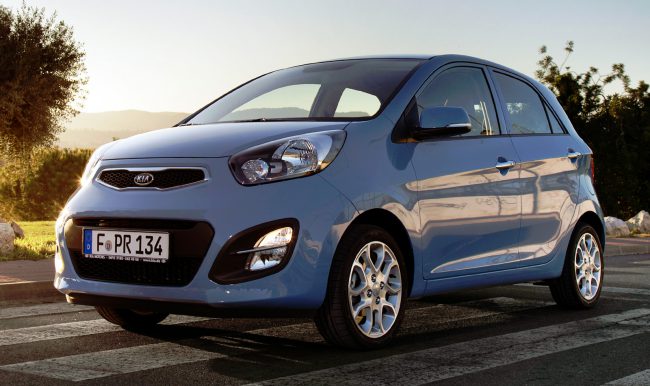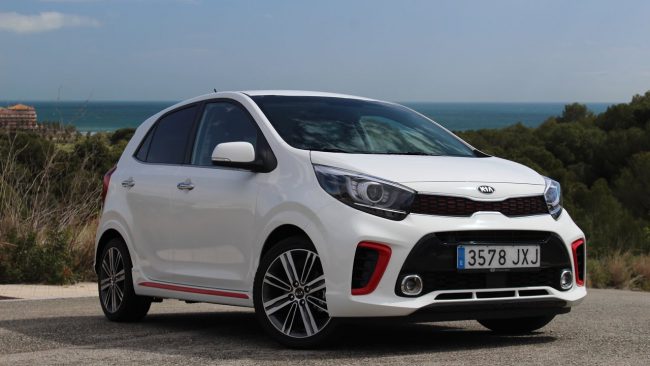
Kia Picanto engines
Content
Kia Picanto is the smallest car in the Korean brand's lineup.
This is a typical representative of city cars, city cars that are designed to huddle in narrow parking lots and push through traffic jams.
They spend almost their entire lives without going to the track. Picanto does not need breathtaking dynamic characteristics.
Much more important is economy, maneuverability and convenience.
Engines Picanto I generations
The first generation of Kia Picanto was introduced in 2003. The car is built on a shortened platform Hyundai Getz. By European standards, Picanto belongs to the A-class. At home, the model was called Morning.
In 2007, a restyling was carried out. Instead of angular headlights and a restrained muzzle, Picanto got playful head optics in the form of droplets. Instead of annoying with loud sounds during the operation of the power steering, they began to install an electric power steering.
In the Russian market, the first generation Kia Picanto was equipped with two engines. In essence, they are twin brothers, only their volume distinguishes them. The motors are one of the representatives of the Epsilon compact gasoline engine series. In the basic modification, a liter unit was located under the hood of the Picanto. It was combined only with a five-speed manual transmission. Those who preferred the "automatic" got a slightly larger engine of 1,1 liters.
For the European market, a 1,2-liter turbodiesel was offered. He gave out 85 horses, which made him the most powerful motor in the Picanto line.
G4HE
The engine with the G4HE index in its entire history was installed only on the Kia Picanto. According to its layout, it is an in-line four-cylinder unit. It is based on a cast-iron block, an aluminum head. The gas distribution mechanism uses a SOHC system with a single camshaft. Each cylinder has three valves. There are no hydraulic lifters, so they need to be manually adjusted every 80-100 thousand km.
 The timing drive uses a belt. According to the regulations, it must be changed every 90 thousand mileage, but there were unpleasant cases when it broke off earlier than this period. It is recommended to reduce the interval to 60 thousand km.
The timing drive uses a belt. According to the regulations, it must be changed every 90 thousand mileage, but there were unpleasant cases when it broke off earlier than this period. It is recommended to reduce the interval to 60 thousand km.
| Engine | G4HE |
|---|---|
| A type | Gasoline, atmospheric |
| Volume | 999 cm³ |
| Bore | 66 mm |
| Piston stroke | 73 mm |
| Compression ratio | 10.1 |
| Torque | 86 Nm at 4500 rpm |
| Power | 60 hp |
| Overclocking | 15,8 with |
| full speed | 153 km / h |
| Average consumption | 4,8 l |
G4HG
The G4HG motor features a slightly modified CPG geometry. The cylinder diameter has grown by 1 mm, and the piston stroke by 4 to 77 mm. Due to this, the working volume increased to 1086 cubes. You will not be able to feel a ten percent increase in power. A sluggish four-speed “automatic” turns the already outstanding dynamics of Picanto into 18 seconds of acceleration to 100 on the passport, which in reality is about 20.
| Engine | G4HG |
|---|---|
| A type | Gasoline, atmospheric |
| Volume | 1086 cm³ |
| Bore | 67 mm |
| Piston stroke | 77 mm |
| Compression ratio | 10.1 |
| Torque | 97 Nm at 2800 rpm |
| Power | 65 hp |
| Overclocking | 17,9 with |
| full speed | 144 km / h |
| Average consumption | 6,1 l |
Epsilon series engines are not considered problematic, but one incident can still come out. The problem is related to the loose fastening of the timing pulley on the crankshaft. The key destroys the groove, as a result of which the belt jumps and knocks down the valve timing. In the best case, with a small displacement, valves that open at the wrong time will simply significantly reduce engine power. With a more sad outcome, the pistons are bent valves.
On engines manufactured after August 26, 2009, the timing drive has been changed and a new crankshaft is installed. It is very expensive to independently remake the mechanism for a new one: the list of necessary spare parts and the amount of work, frankly, is impressive.
There is no engine temperature gauge on the Picanto dashboard. Sometimes the engines overheated. This happened, as a rule, due to a dirty radiator or insufficient coolant level. As a result, it leads the head of the block.
The most common error of the electronic control unit is the failure of the oxygen sensor. In this case, the sensor itself can be completely serviceable. Blame it on worn out spark plugs that can't ignite all the fuel. Its residues enter the catalyst, which is incorrectly interpreted by the sensor as too much gasoline in the air-fuel mixture. On a Picanto with an automatic transmission, this can cause jolts when shifting. Before sinning on the "machine", you should check the ignition system. To avoid problems, change the candles more often (every 15-30 thousand km).
If we are now considering the acquisition of the first generation Picanto, then first of all it is worth paying attention to the general condition. Engines and the machine as a whole are quite reliable. The cost of ownership is very low. But this is provided that the car was looked after and followed.
Engines Picanto II generations
In 2011, the release of a new generation of urban hatchback was ripe, by this time the first Picanto was already celebrating its eighth anniversary. The car has changed drastically. The new exterior is much more modern and trendy. This is the merit of the German designer Peter Schreyer. There was a three-door body.
In the second generation, not only the appearance of the Kia Picanto has undergone major changes, but also the line of power plants. The Epsilon series engines were replaced by Kappa II units. As before, two motors are available to choose from: the first with a volume of 1 liter, the second with 2 liters. New engines are more environmentally friendly and efficient. This was achieved by reducing friction losses in the gas distribution mechanism and the cylinder-piston group. In addition, the motors are equipped with a start-stop system. It automatically shuts off the engine when stopped at traffic lights.
G3LA
 The base unit is now three-cylinder. It only works in tandem with a manual transmission. The head of the block and the block itself are now aluminum. Now there are 4 valves for each cylinder, and not three, as on its predecessor. In addition, the intake and exhaust valves use separate camshafts. Each of them has its own phase shifter, which changes the phase angles to increase engine power at high speeds.
The base unit is now three-cylinder. It only works in tandem with a manual transmission. The head of the block and the block itself are now aluminum. Now there are 4 valves for each cylinder, and not three, as on its predecessor. In addition, the intake and exhaust valves use separate camshafts. Each of them has its own phase shifter, which changes the phase angles to increase engine power at high speeds.
New generation engines are equipped with hydraulic compensators, which relieve the valve adjustment procedure every 90 thousand km. In the timing drive, the designers used a chain that is designed for the entire life of the motor.
By definition, three-cylinder engines are less balanced and balanced than four-cylinder engines. They create more vibrations, their work is noisier, and the sound itself is specific. Many owners are unhappy with the loud operation of the motor.  I must say that the merit is not so much the three cylinders, but the very poor sound insulation of the cabin, characteristic of all cars in this price segment.
I must say that the merit is not so much the three cylinders, but the very poor sound insulation of the cabin, characteristic of all cars in this price segment.
| Engine | G3LA |
|---|---|
| A type | Gasoline, atmospheric |
| Volume | 998 cm³ |
| Bore | 71 mm |
| Piston stroke | 84 mm |
| Compression ratio | 10.5 |
| Torque | 95 Nm at 3500 rpm |
| Power | 69 hp |
| Overclocking | 14,4 with |
| full speed | 153 km / h |
| Average consumption | 4,2 l |
G4LA
Traditionally, the more powerful Picanto motor is only available with an automatic transmission. Unlike the younger unit, there are full four cylinders here. They are similar in design. Aluminum block and cylinder head. DOHC system with double camshafts and phase shifters on each of them. Timing chain drive. Distributed fuel injection (MPI). It is less productive than direct. But more reliable. As the fuel passes through the intake valve, it cleans the skirt of the intake valve, preventing the formation of carbon deposits.
| Engine | G4LA |
|---|---|
| A type | Gasoline, atmospheric |
| Volume | 1248 cm³ |
| Bore | 71 mm |
| Piston stroke | 78,8 mm |
| Compression ratio | 10.5 |
| Torque | 121 Nm at 4000 rpm |
| Power | 85 hp |
| Overclocking | 13,4 with |
| full speed | 163 km / h |
| Average consumption | 5,3 l |
Third generation Picanto engines
The third generation of the compact car was officially launched in 2017. There was no breakthrough in design. It's more of a matured and cocky version of the previous generation Picanto. Designers cannot be blamed for this. After all, the exterior of the predecessor turned out to be so successful that it still did not look outdated. Although the machine has been produced for six years.
As for the engines, it was also decided not to change them. True, they lost a couple of horses due to the tightening of toxicity standards. The three-cylinder engine now produces 67 forces. The power of the 1,2-liter unit is 84 horsepower. Otherwise, these are the same G3LA/G4LA engines from the previous Picanto generation with all the features, strengths and weaknesses. As before, a more powerful motor is equipped only with a four-speed “automatic”. If you remember that the Kia Picanto is a purely city car, then the need for fifth gear is immediately eliminated. But in 2017, installing antediluvian and sluggish four-speed transmissions on cars for a manufacturer like Kia is a bad form.
| Picanto II | Picanto II | Picanto III | |
|---|---|---|---|
| Engines | 1 | 1 | 1 |
| G4HE | G3LA | G3LA | |
| 2 | 1.2 | 1.2 | |
| G4HG | G4LA | G4LA |
By themselves, small-capacity internal combustion engines are not designed for a long resource. Their purpose is to move the car exclusively around the city. The average driver at this pace rarely rolls more than 20-30 thousand km a year. Due to the small volume, the engine is constantly working under heavy load. The very conditions of using the car in the city also have a negative effect on the service life: long idling, long oil change intervals in engine hours. Therefore, the service life of motors of 150-200 thousand is a good indicator.

